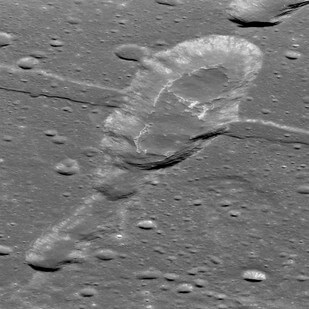Dark outpourings of lava gave the “man in the moon” his face more than three billion years ago. And volcanic activity continued on the moon until it halted a billion years ago – or so lunar scientists have long thought.
However, a new discovery by a group of geologists at Arizona State University’s School of Earth and Space Exploration shows that the moon has seen small but widespread eruptions of basaltic lava during the last 50 million years, a geologically recent period.
The discovery was announced in a paper published online Oct. 12 in Nature Geoscience. Sarah Braden, a recent School of Earth and Space Exploration graduate, is the lead author; the others are Julie Stopar, Samuel Lawrence and Mark Robinson, all researchers in the school, and Carolyn van der Bogert and Harald Hiesinger of the Westfälische Wilhelms-Universität Münster in Germany.
The science team identified 70 small volcanic features scattered across the moon’s dark volcanic plains, or maria. The features show as a combination of smooth, low, rounded mounds near patches of rough, blocky terrain. The scientists refer to these unusual areas as irregular mare patches.
“Finding previously unknown geologic features on the lunar surface is extremely exciting,” says Braden.
The features are too small to be seen from Earth, averaging less than a third of a mile (500 meters) across their largest dimension. One feature named Ina has been known for a long time, having been imaged from lunar orbit by Apollo 15 astronauts in the 1970s. Several early studies indicated that Ina could be very young (10 million years or less), but only a few irregular mare patches were known then, and their significance was unclear.
It was not until the scientists had high-resolution images showing the entire moon that the full extent and significance of the small lava features were understood. These images are the product of the two Narrow Angle Cameras that form part of the Lunar Reconnaissance Orbiter Camera system. Co-author Mark Robinson is the principal investigator for the camera, which is on NASA’s Lunar Reconnaissance Orbiter spacecraft.
The ages of the irregular mare patch features come from studies of crater sizes and numbers within a given area by Braden, assisted by van der Bogert and Hiesinger. These crater-counting dates are linked to laboratory ages provided by Apollo and Luna samples. The results show that instead of lunar volcanism stopping abruptly about a billion years ago, it ended more gradually, continuing until less than 50 million years ago.
Activity at Ina, the scientists found, ended about 33 million years ago, and at another irregular mare patch, Sosigenes, it stopped only about 18 million years ago. (In contrast, most of the lava flows that make up the dark plains visible by eye from Earth erupted between 3.5 and 1 billion years ago.)
“The existence and young age of the irregular mare patches provides a new constraint for models of the lunar interior’s thermal evolution,” Braden says. “The lunar mantle had to remain hot enough for long enough to provide magma for the small-volume eruptions.”
Robinson notes that the new discovery is hard to reconcile with what’s currently thought about the temperature of the moon’s interior. “These young volcanic features are now prime targets for future exploration, both robotic and human.”
The discovery gives the moon’s volcanic history a new chapter. As Braden says, “Our understanding of the moon is drastically changed by the evidence for volcanic eruptions at ages much younger than previously thought possible, and in multiple locations across the lunar maria.”
The Lunar Reconnaissance Orbiter spacecraft is managed by NASA’s Goddard Space Flight Center in Greenbelt, Maryland, and the Lunar Reconnaissance Orbiter Camera’s Science Operations Center is located on ASU’s Tempe campus.



Discovery? Interested in even younger basaltic volcanism on the Moon published much before? Please refer to our peer-reviewed papers published much before: Evidences of relatively new volcanic flows on the Moon (published in current science on 10th Aug, 2014); Young viscous flows in the Lowell crater of Orientale basin, Moon: Impact melts or volcanic eruptions? (Published in Planetary and Space Science in Oct. 2013) ; Active moon: evidences from Chandrayaan-1 and the proposed Indian missions (published in Geoscience Letters – Oct. 2014)